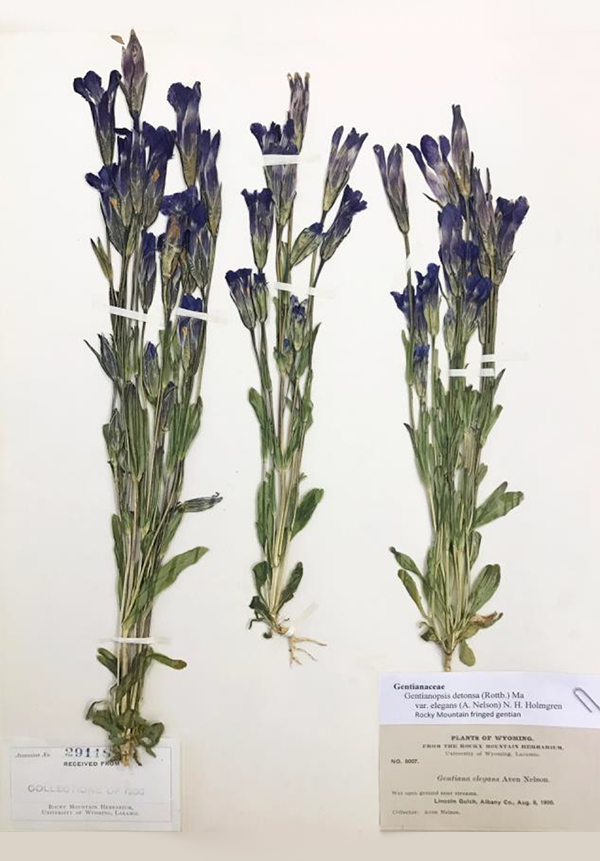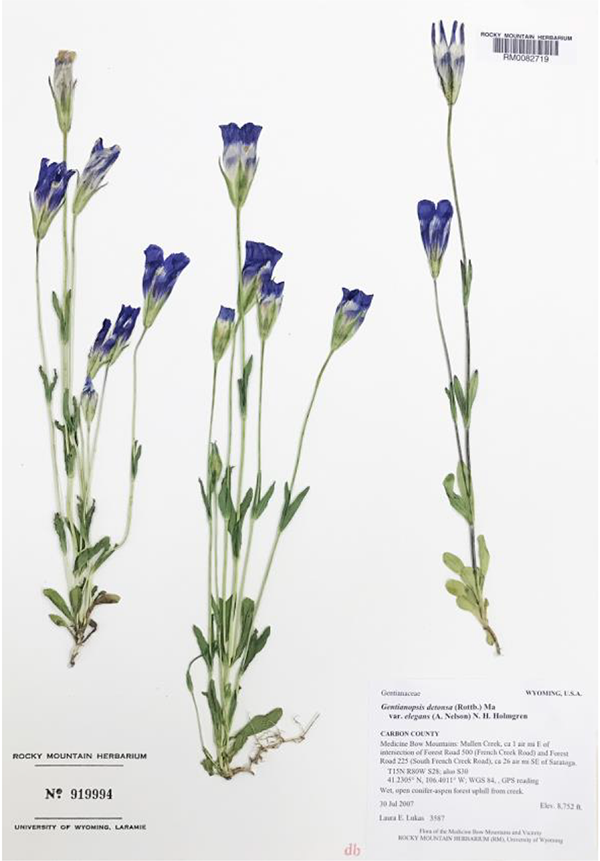Rocky Mountain Herbarium
The Rocky Mountain Herbarium (RM) is the largest facility of its kind between Saint Louis and the West Coast. Rich in material from throughout the US, Canada, and northern Europe, it is the largest collection of Wyoming and Rocky Mountains plants in the world and reflects the region’s biological diversity and evolutionary history. It has been enriched over the past 40 years by an unparalleled inventory program involving 50 floristics graduate students, most of whom have become educators or researchers at state and federal agencies or environmental companies. The studies covered most state and federal lands in Wyoming, Colorado, and northern New Mexico, but also major portions of Montana, Idaho, and parts of eight adjoining states. With help from staff and associates, the number of new collection exceeds 650,000. The Rocky Mountain Herbarium, U.S. Forest Service National Herbarium, and the W.G. Solheim Mycological Herbarium contain more than 974,600 specimens and an additional 300,000 specimens await mounting. Based on the number of collections, it ranks 15th in the nation of 641 herbaria, and 75th in the world of 2,962 herbaria. Also at represented is the A.A. Beetle Grass Herbarium withover 30,000 collections (Ecosystem Science and Management). Thus, holdings at UW exceed 1 million accessioned specimens. The Rocky Mountain Herbarium database contains more than 850,000 entries and 140,000 specimen images, the latter facilitated by collaboration with UW Libraries staff. This treasure trove of primary information, with a mapping function, is used extensively by the scientific community, state and federal agencies, and the public. Our informatics program is part of a regional and national consortium. In the last 20 years alone, the Rocky Mountain Herbarium has received more than $1,670,000 in mostly federal funding (84 projects) for graduate student education and specimen acquisition, processing, curation, databasing, and imaging. This has led to the employment of over 300 undergraduates, many of whom have been in the internship program.Our studies have vastly increased knowledge of rare plants. Field work completed during the 1990s in Colorado, Idaho, Utah, Washington, and Wyoming resulted in the inventory of 79,391 square miles of state and federal lands. Most importantly, 414 species of conservation concern were documented at 1,458 sites; most of these sites of occurrence were new. Additionally, projects completed during the first decade of the 2000s in Arizona, Colorado, Idaho, Kansas, Nebraska, New Mexico, Oregon, South Dakota, Washington, and Wyoming resulted in the coverage of an additional 89,363 square miles. During this period, 430 plantspecies of conservation concern were documented at 1,678 sites. As many of the taxa collected during the 1990s had been removed from Natural Heritage lists prior to 2000, this is even more remarkable. This vast increase in knowledge has influenced the removal of many potential or proposed species from the Federal Threatened and Endangered Species List. This work has been done in conjunction with the Wyoming Natural Diversity Database and other Natural Heritage Programs in the region.
The Rocky Mountain Herbarium continues to serve a critical role inproviding plant identifications to the public, UW students and faculty, and state and federal agencies.We work closely with these agencies in documenting the introduction and spread of invasives and noxious weeds throughout the region.The Curator is a coauthor of the Weeds of the West. We assist the Wyoming Game and Fish Department and the Veterinary Lab with cases of wildlife and livestock poisoning. We provide material for use in courses, including plant taxonomy, plant ecology, and general biology, and guide tours for K-12 classes in coordination with Biodiversity Institute, students in UW courses, and the public. We work with UW Extension in conducting workshops and field trips for the public on plant identification. In addition to education and service, the Rocky Mountain Herbarium, with the associated branch of UW Libraries (>5,000 printed volumes, 4,600 microfiche titles), serves a major role in research. It contains primary material that supports the writing of popular guides and scholarly works on plants identification, including the floras of Rocky Mountain National Park, the Medicine Bow Range, the Black Hills, Wyoming, and Montana. Staff and associates have described many new species and the Rocky Mountain Herbarium is a repository for more that 5,900 type specimens on which new species are based. We have published numerous taxonomic and systematics treatments of genera in the sunflower, carnation, and parsley families of western US and the pineapple family of South America.These treatments are based on morphological and anatomical studies of herbarium specimens and living material, but may also include analyses of chromosome number and behavior, flavonoid chemistry,and chloroplast DNA. We have contributed treatments to the floras of California, Oregon, New Mexico, Missouri, and the Great Plains. For many years the past Curator served on the Board of Directors for the Flora of North America(FNA) project and the Rocky Mountain Herbarium is a center for regional review. We have also contributed numerous FNA treatments. Thus far, 20 of 30 volumeshave been published by Oxford University Press (12,493 pp.). Upon completion in 2020,it will contain identification keys, descriptions, and illustrations of more than 22,000 species. In conducting research through the years, we have worked atmany herbaria in the New World and have borrowed for study, several thousand specimens from all the major collections in North America. Likewise, tens of thousands of specimens from RM have been loaned for systematic study as well.


Specimens of Rocky Mountain fringed gentian (Gentianopsis detonsa var. elegans).
The top collected by Aven Nelson in 1900, the bottom by Laura E. Lukas in 2007.
